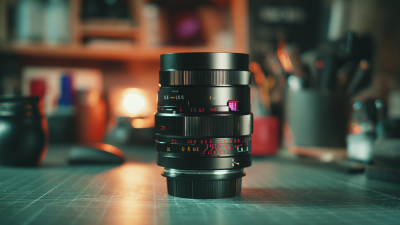High Index Lenses are a significant advancement in the field of optometry, designed to improve vision quality while providing thinner and lighter eyewear solutions. According to the Vision Council, over 75% of adults in the U.S. require vision correction, and with traditional lenses, individuals with stronger prescriptions often face bulky eyewear that can affect both aesthetics and comfort. High Index Lenses, which are made from materials that have a higher refractive index, allow for the creation of thinner lenses that are up to 50% lighter than regular plastic lenses, enhancing comfort and style without compromising vision. Furthermore, a report from the American Academy of Ophthalmology highlights that these lenses can reduce distortion and improve peripheral vision, resulting in a more effective visual experience for wearers. As the demand for visually appealing and functional eyewear continues to grow, High Index Lenses represent an essential innovation in optical design, catering to the needs of a diverse population.

High index lenses are specially designed optical lenses made from materials with a higher refractive index than standard lenses. This unique composition allows them to bend light more efficiently, resulting in thinner and lighter lenses, which is particularly beneficial for individuals with strong prescriptions. The high refractive index not only enhances the optical performance but also contributes to a more aesthetically pleasing appearance, as these lenses can significantly reduce the bulkiness typically associated with high prescription eyewear.
In addition to their lightweight features, high index lenses often include advanced treatments that can further improve vision quality. Many of these lenses come with anti-reflective coatings, which minimize glare and enhance clarity by allowing more light to pass through the lens. Moreover, high index lenses are less susceptible to scratching and offer UV protection, making them a versatile choice for various environments. The combination of superior aesthetic appeal and enhanced visual performance makes high index lenses an increasingly popular option for those seeking optimal vision correction.
High index lenses are a game changer for those seeking enhanced vision quality. These lenses are crafted from materials that have a higher refractive index, allowing them to bend light more effectively than standard lenses. This means they can be made thinner and lighter, which not only improves comfort but also helps to reduce the distortion often associated with thicker glasses. This reduction in bulk is particularly beneficial for individuals with stronger prescriptions, allowing them to wear stylish frames without the added weight.
One of the key benefits of high index lenses is their ability to enhance clarity and comfort. The thinner profile of these lenses minimizes the visual distortion at the edges, providing a more natural field of vision. Additionally, many high index lenses come with advanced coatings that reduce glare and reflections, making them a great choice for driving at night or in bright conditions. By investing in high index lenses, wearers can experience improved visual performance along with the aesthetic appeal of slimmer frames, making them a worthwhile consideration for anyone looking to upgrade their eyewear.

High index lenses represent a significant advancement in eyewear technology, particularly when compared to standard lenses. The primary distinguishing feature between these two lens types lies in their refractive index. High index lenses, typically ranging from 1.61 to 1.74, are designed to bend light more efficiently than standard lenses, which usually have a refractive index of around 1.50. This increased efficiency allows for the production of thinner and lighter lenses, making them particularly advantageous for individuals with stronger prescriptions. According to the Vision Council, nearly 65% of eyewear consumers now prioritize lens thickness and weight, reflecting a growing demand for comfort and aesthetics.
When analyzing the weight difference, high index lenses can be up to 50% lighter than standard lenses, which significantly enhances wearability. For instance, a pair of high index lenses for a -4.00 prescription could weigh approximately 30-40% less than equivalent standard lenses. This reduction not only contributes to a more comfortable fit but also decreases the risk of lens distortion, ensuring better vision quality overall. As eyewear technology continues to evolve, the superiority of high index lenses becomes more evident, providing users with both practical benefits and enhanced visual clarity.

The global optical market is witnessing a remarkable shift in lens technology, particularly with the growing adoption of high index lenses. These lenses offer a thinner, lighter alternative to traditional lenses, significantly enhancing the comfort and aesthetics of eyewear. Recent reports indicate that the eyewear market is poised for substantial growth, projected to reach USD 323.76 billion by 2030. This surge in demand is driven by an increasing awareness of optical health and the need for more advanced visual solutions, setting the stage for high index lenses to become a staple in modern eyewear.
As consumers become more discerning about their eyewear choices, high index lenses are increasingly favored for their superior visual quality. Companies in the optical industry are capitalizing on this trend by introducing innovative designs and materials that cater to various lifestyles and preferences. One exciting development is the shift towards plant-based frames and lenses, which not only align with sustainability goals but also attract environmentally conscious consumers.
Tips: When considering high index lenses, look for options that offer anti-reflective coatings to enhance clarity and reduce glare. Also, remember to select frames that complement the weight and thickness of your lenses for optimal comfort. Regular eye exams are essential to ensure your lenses meet your evolving vision needs.
High index lenses are designed to provide superior visual acuity for individuals with stronger prescriptions. Their thinner and lighter profile makes them a popular choice among wearers, especially those who struggle with the bulkiness of traditional lenses. The performance metrics of high index lenses reveal significant advantages, particularly for individuals with higher prescription strengths. These lenses minimize distortion and enhance visual clarity across various distances, effectively improving overall vision quality.
When considering high index lenses, it's important to think about factors such as lens material, coating options, and compatibility with your optical prescription. Here are a few tips for selecting the best high index lenses for your needs:
These coatings reduce glare, enhance clarity, and make lenses appear nearly invisible, ensuring an unobstructed view.
Depending on your lifestyle and digital device usage, you may want to explore specific lens designs—like progressive lenses for presbyopia—that offer seamless vision transitions without compromising comfort.







